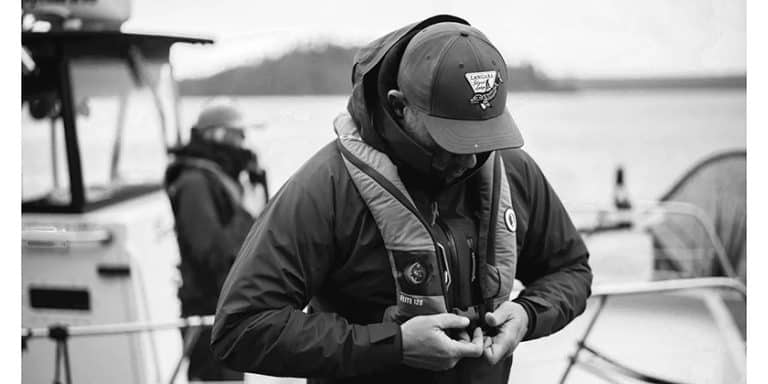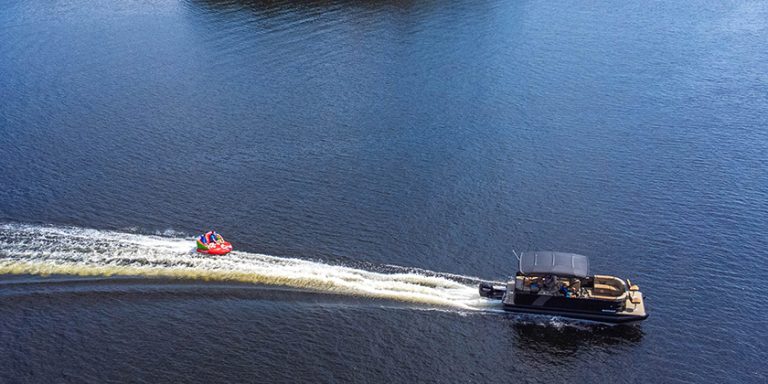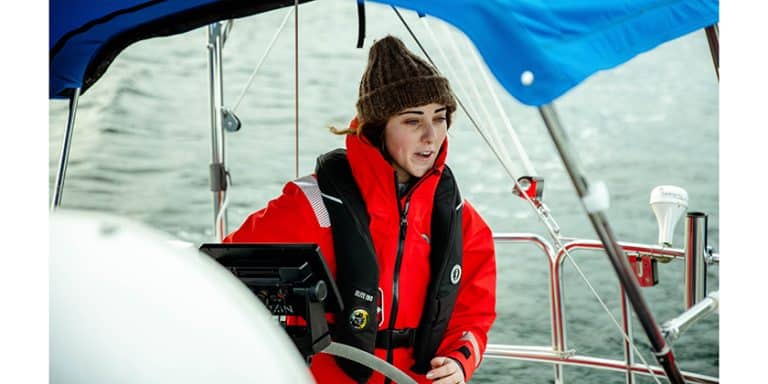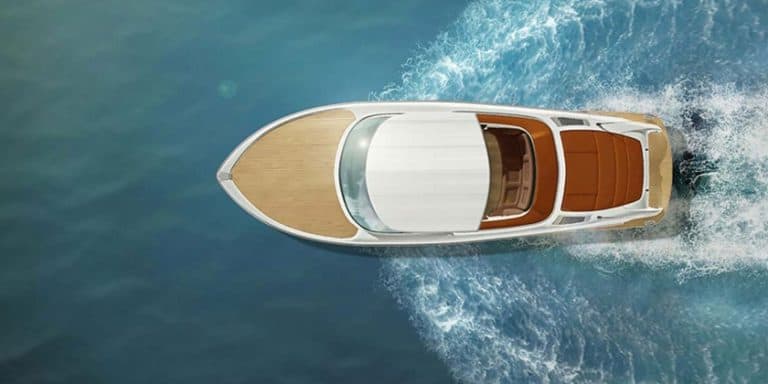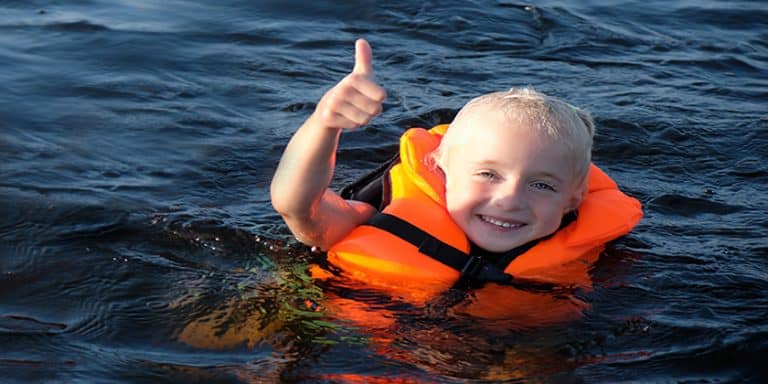Beware of What You Cannot See
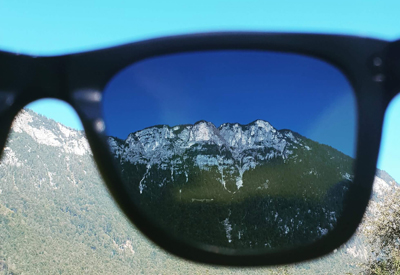
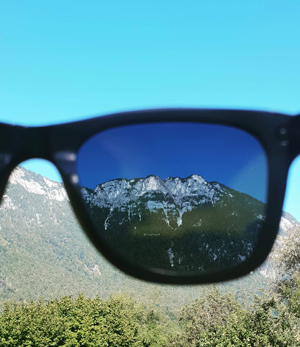 By Katherine Stone
By Katherine Stone
Polarization makes everything clearer, more defined and enhances the colour contrasts.
When every January ebbs and February approaches, Canadians look forward to more hours of sunshine AND actual sunshine. Seeing that sun poke through the clouds on a winter’s day is the most delightful sight in the world and brings with it the hope of spring and the long days on the water to come.
As a sailor and skier, I have spent more than half my life on water, whether in a liquid or frozen form! As kids, we NEVER wore a hat (except if it was really cold) and sunglasses were what our parents wore. Well, I got older and realized that I could no longer spend countless hours in the sun without some kind of eye protection, as the glare made it almost impossible to see, even with my dark brown eyes. I had never thought too much about what type of sunglasses to buy – other than they had to look cool when I was younger and more sophisticated as I got older. I always had a pair in the car, sailing or ski bag, you know, like the ones you get as a prize or freebie in a swag bag. So, I decided to do a little research to learn more about protecting one of the most useful organs that I own, which is a component of the intricate frame of organized systems in my body -my eyes!
Most people think that proper eye care consists of visiting an ophthalmologist or optometrist on a regular basis. These professionals can only recommend medicines, devices and procedures, however, taking good care of your eyes and avoiding poor practices is up you. General health problems are often linked to any type of problem that you may have with your eyes. Spending long hours in front of any type of screen, whether they be TV, iPads or phones along with long hours driving cause strain and ill-use. Smoking, especially chain smoking, causes loss of sight and is a leader in diseases such as macular degeneration – creating dead spots in the eyes. But there is something even more sinister lurking out there.
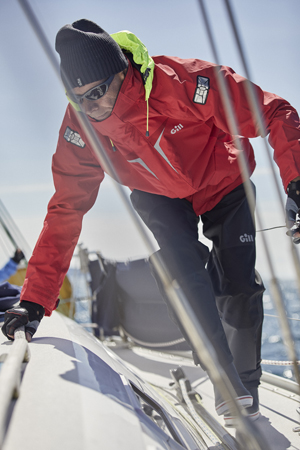 Have your eyes ever felt gritty and watery after a day on the water or on the slopes? Did you have temporary vision loss or felt a burning sensation? If this sounds familiar, you have most likely been exposed to UV rays from light reflection. “Even short-term effect of over UV exposure can cause a ‘sunburn’ of the eyes. Symptoms are pain, tearing, photophobia [an experience of discomfort or pain to the eyes due to light exposure] or blurred vision.” Says Dr. Maria Sirounis Sirmis, a Toronto optometrist. “It can take 24-72 hours to resolve with artificial tears and sometimes even steroids.”
Have your eyes ever felt gritty and watery after a day on the water or on the slopes? Did you have temporary vision loss or felt a burning sensation? If this sounds familiar, you have most likely been exposed to UV rays from light reflection. “Even short-term effect of over UV exposure can cause a ‘sunburn’ of the eyes. Symptoms are pain, tearing, photophobia [an experience of discomfort or pain to the eyes due to light exposure] or blurred vision.” Says Dr. Maria Sirounis Sirmis, a Toronto optometrist. “It can take 24-72 hours to resolve with artificial tears and sometimes even steroids.”
Photokeratitis or ultraviolet keratitis is a painful eye condition caused by exposure of insufficiently protected eyes to the ultraviolet (UV) rays from either natural (intense sunlight) or artificial (the electric arc during welding) sources. Ultraviolet light is invisible high energy light that can penetrate exposed parts of the body – including the eyes. In a nutshell you need to be aware of both UV-A and UV-B.
UV-B is what gives you the burn and is a contributing factor to macular degeneration. UV-A is the stronger of the two and what causes more deeper damage linked to photokeratitis, formation of cataracts, ocular melanoma (cancer of the eye or eyelids), and benign growths on the eye’s surface (pingueculae and pterygiums). “Even though we cannot see UV light, it is absorbed into the eye tissues. The amount of UV is cumulative which can cause long term eye problems,” explains Dr. Sirounis Sirmis. “Just as we use sunscreen to protect our skin, we also must protect our eyes by wearing sunglasses. This is especially important for being on the water while boating because not only are you receiving the direct sunbeams with UV from above, you are also receiving sunrays that are reflected off the water into your eyes, because the water acts like a reflecting surface.”
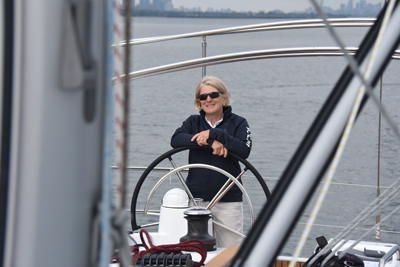 Even on a cloudy day – wearing sunglasses is important to protect against UV rays.
Even on a cloudy day – wearing sunglasses is important to protect against UV rays.
So, I have my sunglasses and I always wear a hat on the water. Albeit a baseball cap – when it really should be a wide brimmed hat. I’m ok, right? Well, my sunglasses are those swag bag ones, remember? So, I got in contact with Jill Brown, Associate Brand Manager at Maui Jim Sunglasses for some further advice on what to look for when purchasing sunglasses – for the best protection on the water. Their Kanola Coast sunglasses are a favourite with boaters. She says that it basically boils down to three critical elements:
1) quality polarization – it eliminates uncomfortable glare (and allows you to see into the water!)
2) comprehensive UV-A, UV-B and HEV [higher energy visible light] protection – it will protect your irreplaceable eyes
3) colour-enhancing technology – to give you views full of colour, clarity and detail, especially for boaters.
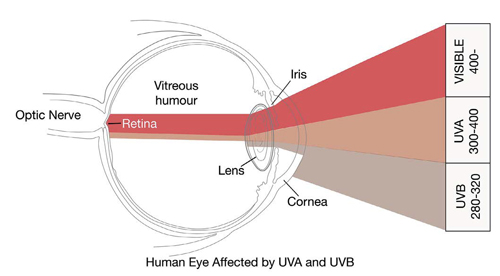

The great thing is that even contacts can be purchased with UV blocking capabilities, along with clear eyeglass lenses. The bigger and/or more wrap-around the frame, the more protection you have. Look for 100% UV protection or sunglasses that offer UV absorption of up to 400 nm. Dr. Sirounis Sirmis stresses that, “Children are at much greater risk of UV damage because their pupils are larger than adults and their crystalline lens is clearer, so naturally they do not filter UV as well as adults. Studies show that individuals get 80% of their cumulative lifetime UV dose by the age of 18.”
Not only do polarized glasses reduce the glare off the water, they also allow you to better see rocks, shoals, debris or deadheads just below the surface. The only downside is that the LCD screens that we often refer to on our electronic equipment on the boat are also polarized. If you tilt your head or lean over the screen often becomes black. The two polarized lenses will still allow light to get through, however, if they are at 90 degrees to each other, no light will pass through.
There are an abundance of coloured lenses to choose from and it really boils down to preference and what activities you do outdoors. Oakley’s Andy McSorley explains that, “Of all the light waves interacting with our eyes, those at the blue end of the light spectrum are most powerful. Cones in the eye’s retina read color, and it’s the blue light that dominates our vision, washing out our perception of other colors. Blue light can limit the eye’s ability to focus, creating chromatic aberration or blurriness, especially in aquatic and snowy environments where blue light is prevalent.” He offers some advice on what to look for in coloured lenses.
Grey is the most popular and universal as it gives a darker version of what you would see without sunglasses. It is great for intense sun days and makes greens and reds stand out.
Yellow enhances contrast. It is ideal for reading details in low-light or overcast conditions – allowing sailors to see puffs on the water’s surface.
Blue mirror lens coatings reduce glare because they are blue which reflects the light away from the eye. These are the ones for you if you plan to spend time in the Caribbean where they have bright blue skies.
Red really heightens contrast in variable conditions but there are big colour imbalances.
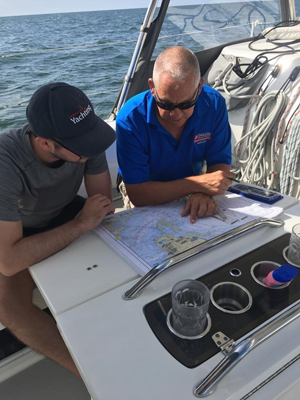 Reading a chart and plotting a course is much easier with sunglasses.
Reading a chart and plotting a course is much easier with sunglasses.
Bronze, amber or copper creates contrast which heightens visibility in variable light. Easy on the eyes, distinguishing breeze and wave height is enhanced on grey or dark water with little to no colour distortion.
Ok, got the glasses – now what? Well – to start off, the first time you put them on and then look down into the beautiful blue water, off they go into the watery abyss and your expensive acquisition and the wonderful protection for your baby blues are gone! So, don’t forget to wear a band to help make those sunglasses extra secure for boating activities, especially on a high speed PWC. Remember that the overall fit and quality will affect your comfort and durability.
Finally, caring for your investment is key. High quality sunglasses will come in a case with a proper cleaning cloth which is ideal for using on your lenses. When this isn’t available, breathe on them or wet them with water (never with saltwater!) and wipe them gently with a soft cloth. Avoid using paper towels, napkins or toilet paper as these will scratch the lenses. If you do end up with saltwater on them, which will inevitably happen on those lovely windy days, use a mild soap and rinse them under fresh water. If they are really clean, the lenses will repel water so you will only need to dry the frames.
I think that I will ditch those cute little white-framed glasses and start to wear the beautiful pair of 100% UV protection sunglasses that my husband bought for me ALL the time. There is no time like the present to protect one of the most precious gifts that we all have – your eyes!


